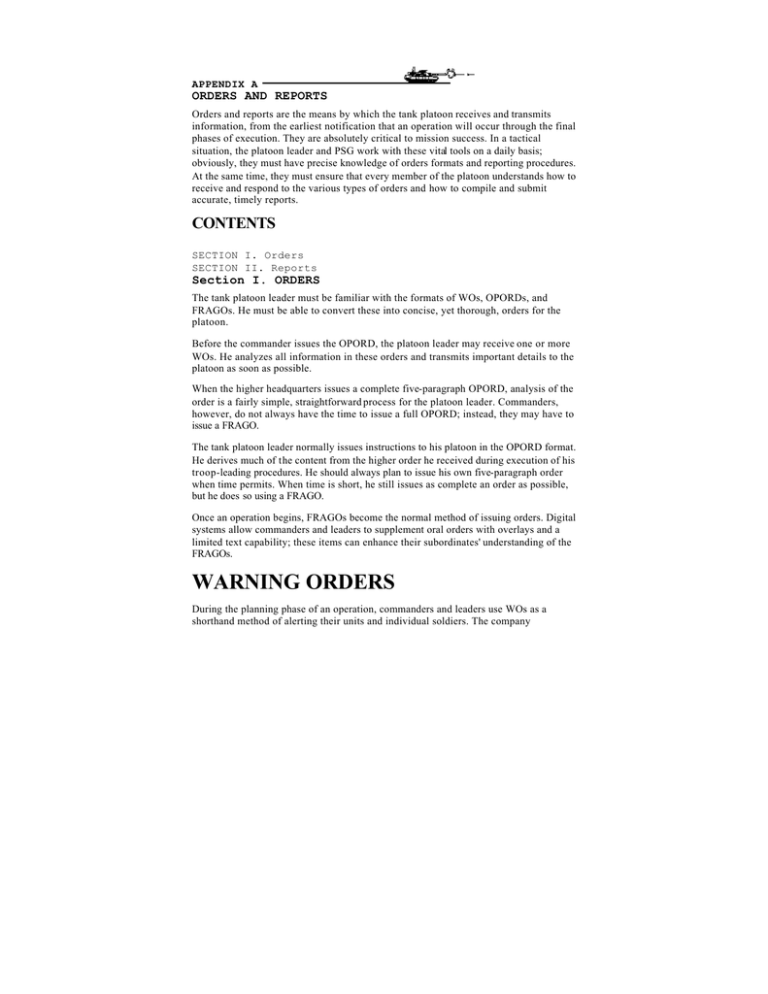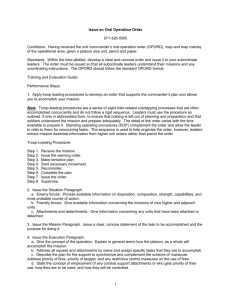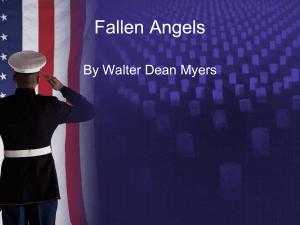ORDERS AND REPORTS
advertisement

APPENDIX A ORDERS AND REPORTS Orders and reports are the means by which the tank platoon receives and transmits information, from the earliest notification that an operation will occur through the final phases of execution. They are absolutely critical to mission success. In a tactical situation, the platoon leader and PSG work with these vital tools on a daily basis; obviously, they must have precise knowledge of orders formats and reporting procedures. At the same time, they must ensure that every member of the platoon understands how to receive and respond to the various types of orders and how to compile and submit accurate, timely reports. CONTENTS SECTION I. Orders SECTION II. Reports Section I. ORDERS The tank platoon leader must be familiar with the formats of WOs, OPORDs, and FRAGOs. He must be able to convert these into concise, yet thorough, orders for the platoon. Before the commander issues the OPORD, the platoon leader may receive one or more WOs. He analyzes all information in these orders and transmits important details to the platoon as soon as possible. When the higher headquarters issues a complete five-paragraph OPORD, analysis of the order is a fairly simple, straightforward process for the platoon leader. Commanders, however, do not always have the time to issue a full OPORD; instead, they may have to issue a FRAGO. The tank platoon leader normally issues instructions to his platoon in the OPORD format. He derives much of the content from the higher order he received during execution of his troop-leading procedures. He should always plan to issue his own five-paragraph order when time permits. When time is short, he still issues as complete an order as possible, but he does so using a FRAGO. Once an operation begins, FRAGOs become the normal method of issuing orders. Digital systems allow commanders and leaders to supplement oral orders with overlays and a limited text capability; these items can enhance their subordinates' understanding of the FRAGOs. WARNING ORDERS During the planning phase of an operation, commanders and leaders use WOs as a shorthand method of alerting their units and individual soldiers. The company commander usually sends a series of WOs to his platoon leaders. These orders help subordinates prepare for new missions by providing directions and guidelines for platoon-level planning and preparation. Each platoon leader immediately analyzes the information, then issues a WO of his own to alert the platoon to the upcoming operation. WOs generally follow the five-paragraph OPORD format (illustrated in Figure A-2, pages A-5 through A-9). The key consideration is that they should be as brief as possible while giving units and soldiers the information they need to begin preparing for the operation. A company-level WO normally includes these elements: o Enemy situation. o Higher headquarters' mission. o Commander's intent (if available). o Earliest time of movement. o Specific instructions for preliminary actions (including security, reconnaissance, rehearsals, training, maintenance, resupply, rest, movement, and coordination requirements). o Time and place at which the company OPORD will be issued. Before he issues his own WO, the platoon leader should send graphics to the TCs, either by traditional overlay or using digital systems (if available). The order is almost always given orally and in person, but it may be issued by radio or, on digitally equipped tanks, using the free-text message capability. As a minimum, the platoon WO includes the following information: o Updated enemy situation. o Company and platoon mission statement. o Company commander's intent (if available). o A tentative timeline to include the following: o Earliest time of movement. o Specific instructions for preliminary actions (including security, reconnaissance, rehearsals, training, maintenance, resupply, rest, movement, and coordination requirements). o Time and location at which the platoon OPORD will be issued. If he knows other times, events, or details related to the operation, the platoon leader may include the information in the WO. Figure A-1 shows an example of a platoon WO. "REFERENCE OPERATIONS ONE OVERLAY: AN ENEMY BMP PLATOON HAS SET UP A HASTY DEFENSE ON OBJECTIVE DOG. AT 2300 HOURS, THE COMPANY ATTACKS ALONG AXIS THUNDER TO SEIZE OBJECTIVE DOG. WE WILL LEAD THE COMPANY FORMATION AND SUPPORT BY FIRE ASSAULTS BY BLUE AND WHITE." Figure A-1. Sample platoon warning order. OPERATION ORDERS When time and information are available, the company commander will normally issue a complete OPORD as part of his troop-leading procedures. The OPORD provides platoon leaders with the essential information required to conduct the operation and to carry out the company commander's intent. The commander should distribute graphics (traditional and digital) before issuing the OPORD. Five-paragraph OPORD Format Whenever possible, the OPORD is issued orally in the five-paragraph format. This helps to ensure that required information is presented in a logical manner. Although the fiveparagraph format is straightforward, every commander will develop techniques that allow him to make a clearer, more concise OPORD presentation. The platoon leader should request a copy of his commander's OPORD format to facilitate note-taking. See FM 71-1 for more information concerning company OPORDs. Figure A-2 (pages A-5 through A9) illustrates a sample platoon OPORD format. Issuing the Platoon OPORD Issuing the OPORD is, in effect, a type of drill, with contents and delivery procedures covered by SOPs and other guidelines. The platoon leader must understand, however, that simply reading off the five paragraphs word for word is usually ineffective. His number-one consideration is effective communication. He must fully understand all aspects of the operation and know how to describe and discuss them. He must integrate the friendly and enemy situations and the effects of terrain and weather into the platoon maneuver plan. To make the order even more understandable, the platoon leader should use visual aids to illustrate key points. These premade and field-expedient materials may include the operation map and accompanying overlays; terrain models or impromptu sand tables; and sketches on dry-erase boards, MRE boxes, butcher paper, or the back of a map. As far as possible, the platoon leader must establish optimum physical conditions that will allow effective presentation of the OPORD. For example, the site at which the platoon order will be issued should afford adequate security and minimum distractions. At night, this may require gathering the TCs in one tank or under a tarp supported by gun tubes. The platoon leader must ensure that the TCs post correct graphics on their overlays and/or digital displays. TCs should arrive at the OPORD site early to study maps and to post graphics. Units with digital capability should already have posted the graphics on their vehicle displays before the platoon leader issues the order. TASK ORGANIZATION (company). 1. SITUATION a. Weather and light data. (1) Light conditions: BMNT:_____; Sunrise:_____; Sunset:_____; EENT:_____; Moonrise:_____; Moonset:_____; Percent Illumination:_____. (2) Weather forecast for the operation. (3) Effects of weather and light conditions on the operation. (a) Trafficability. (b) Visibility. (c) Effect on lasers/thermals. b. Terrain. (1) Obstacles, hills, valleys, road types and conditions, streams, rivers, bridges, built-up areas. (2) Avenues of approach. (a) Size unit t hat can be supported. (b) Start and end point. (c) Objective. (3) Key terrain (discuss how friendly and/or enemy forces may attempt to use it to their advantage). (4) Observation and fields of fire. (5) Cover and concealment. (6) Engagement areas. (7) Overall effect of terrain on the operation. c. Enemy forces. (1) Identification. (2) Activity. (3) Location. (4) Disposition. (5) Strength. Figure A-2. Sample platoon OPORD format. (6) Composition, to include type and capabilities of equipment. (7) Other enemy information critical to the upcoming operation, to include the following: (a) Chemical and nuclear capabilities. (b) Air defense artillery (ADA). (c) Aviation, including helicopters. (d) Electronic warfare. (8) Enemy courses of action (discussion should focus on identifying enemy's most probable courses of action). d. Friendly forces (include the following items as applicable). (1) Mission of higher headquarters (company team/troop), including commander's intent and scheme of maneuver. (This may include a review of the task force or squadron scheme of maneuver or commander's intent.) (2) ID/mission of adjacent units (left, right, front, rear). (3) ID/mission of reserves in higher headquarters. (4) ID/mission of supporting units with a direct support/ reinforcing (DS/R) role to higher headquarters (field artillery, engineer, ADA). (5) Which higher headquarters element has priority of fires. (6) Close air support (CAS) allocated to higher headquarters, including number of sorties available. e. Attachments and detachments to the platoon and higher. 2. Mission. This is the WHO, WHAT, WHEN, WHERE, and WHY. State essential task(s) to be accomplished by the entire unit, to include on-order missions. Clearly define the platoon's objective. 3. Execution. Intent. Using the commander's intent as a guideline, the platoon leader may issue his own intent to define the purpose, method, and end state of the operation. The purpose is the WHY of the operation. The method tells how the platoon leader visualizes achieving success with respect to the company/troop mission as a whole and outlines, in general terms, use of combat multipliers. The end state specifies final disposition of forces and explains how the end state will facilitate future operations. a. Concept of the operation. This paragraph further explains and expands on the platoon leader's (and/or commander's) intent, particularly his vision of HOW he will conduct the operation and WHO he will assign to execute it. The platoon leader uses a concept statement when he feels more detail is necessary to ensure subordinates will take the appropriate actions in the absence of additional communications or further orders. The sequence of subparagraphs is as follows: (1) Scheme of maneuver. This is how the platoon will maneuver to kill the enemy or to accomplish its mission. It conforms with the commander's intent. In offensive operations, it specifies the platoon's formation, movement technique, routes or avenues of advance, and plans for direct fire and overwatch. In defensive operations, it specifies the platoon engagement plan, battle positions, orientation of weapons, and the plan for movement to subsequent positions. (2) Fires. (a) Purpose for field artillery and mortar fires (how fires will be used to support the maneuver). (b) Priority of fires within the platoon/company. (c) Allocation of final protective fires (FPF). (d) Preparation starting time and duration of fires. (e) Triggers (trigger line/point or event). (f) Description of enemy fires in the area of operations. (g) Special fire allocation/use (smoke, illumination, CAS). (h) Restrictions. (3) Engineer support (obstacles, mines, and fortifications). (a) Priority of engineer effort (mobility, countermobility, survivability). (b) Priority of engineer support. (c) Obstacle overlay. (d) Obstacle list. (e) Logistical constraints. (f) On-order missions. b. Specific instructions. List specific missions, in "battle sequence," for each tank, including attached elements. Include movement techniques, flank coordination requirements, other details, and be-prepared missions. c. Coordinating instructions. (1) Time schedule for critical events. (a) Rehearsals. (b) Confirmation briefings (back-briefs). (c) Precombat inspection. (d) First movement. (e) Arrival of any attachments/detachments. (f) Boresighting. (2) Movement instructions. (3) Passage of lines. (a) Contact points. (b) Passage points. (c) Lanes, to include identification/markings. (4) Actions at danger areas. (5) Actions on expected contact. (6) Rally points. (7) Rules of engagement (ROE). (8) Intelligence requirements (IR), to include priority intelligence requirements (PIR). (9) Air defense warning and weapons control status. (10) MOPP level and OEG data. (11) Any changes regarding battlesight and battlecarry ranges. (12) Be-prepared tasks or other general information not provided in concept of the operation or specific instructions. 4. Service Support. a. Location and movement plan of the company/troop trains (initial and subsequent grids). b. Material and services. (1) Supply. (a) Priorities of supply. (b) Resupply points and prestock sites. (c) Ration cycle. (d) Location of task force trains. (2) Transportation. (a) Supply routes. (b) LRPs. (c) Priorities established on MSRs. (3) Services. Handling of KIAs. (4) Maintenance. (a) Maintenance procedures. (b) Vehicle evacuation. (c) Task force UMCP location. c. Medical evacuation and treatment. (1) Location of company/troop medics. (2) Location of battalion/squadron aid station. (3) Procedures for treatment and evacuation of WIAs. (4) Aeromedical evacuation information. (5) Location of ambulance exchange points. (6) Handling of contaminated WIAs. d. Personnel. (1) Handling and disposition instructions for enemy prisoners of war (EPW). (2) EPW guard instructions. (3) Location of EPW collection point. (4) Instructions for interaction with local civil populace (ROE). (5) Number of expected replacements. (6) Cross-leveling procedures. e. Miscellaneous. 5. Command and Signal. a. Command. (1) Location of commander, XO, TOC, and/or TAC CP. (2) Succession of command. b. Signal. (1) SOI index and edition in effect. (a) Key frequencies. (b) Key call signs. (c) Current item number identifier. (2) KY-57 fill and changeover data. (3) Listening silence instructions. (4) Challenge and password. (5) Special signals, to include use of pyrotechnics. (6) Code words. (7) Digital traffic instructions (IVIS and digital systems only). (8) Actions to counteract jamming or "hot mike" situations. TIME CHECK (for synchronization). Figure A-2. Sample platoon OPORD format (continued). FRAGMENTARY ORDERS The FRAGO is a brief oral or written order that can serve any of the following purposes: o Implement timely changes to existing orders. o Provide pertinent extracts from more detailed orders. o Provide instructions until a detailed order is developed. o Provide specific instructions to subordinates who do not require a complete order. There is no specific format for a FRAGO. For simplicity and complete clarity, it normally follows the five-paragraph OPORD structure; however, it includes only the information required for subordinates to accomplish their mission. To enhance understanding of voice FRAGOs, digitally equipped units can quickly develop hasty graphics and transmit digital overlays. The platoon FRAGO normally includes the following information: o Updated enemy or friendly situation. o Mission (ensure platoon tasks and purpose are clear). o Scheme of maneuver. o Specific instructions as necessary. Figure A-3 illustrates a platoon FRAGO transmitted by voice over a secure net. "RED, THIS IS RED ONE. FRAGO FOLLOWS." "WHITE IS IN CONTACT AND SUPPRESSING 2 T80s VICINITY NK77368900. BLUE IS MOVING TO CHECKPOINT 26 TO SUPPRESS THE T80s." "OUR MISSION IS TO ASSAULT AND DESTROY THE T80s TO ALLOW BRAVO COMPANY TO CONTINUE THE ATTACK NORTH." "WE WILL MOVE IN A PLATOON WEDGE THROUGH WAYPOINTS 2 AND 5, GET ON THE FLANK OF THE T80s, AND ASSAULT FROM EAST TO WEST." "RED 4, ENSURE THAT BLUE AND WHITE SHIFT FIRES WEST AS WE BEGIN OUR ASSAULT, OVER." Figure A-3. Sample platoon FRAGO. Section II. REPORTS Report s are the primary means of providing information for plans and decisions. They must be accurate, timely, and complete. Procedures for preparing, transmitting, and safeguarding reports will vary from unit to unit and from situation to situation. Among the factors influencing report procedures are the preferences and requirements of the chain of command, the tactical environment in which the platoon is operating, available equipment, terrain, and the electronic warfare situation. Digital systems, for example, enable the transmission of accurate preformatted reports. One factor, however, remains constant for leaders at all levels: the importance of compiling timely, accurate information and of relaying that information by the clearest, quickest, and most secure method possible. Every platoon leader can save time, ensure completeness, and reduce confusion in this process by developing and implementing thorough SOPs covering report procedures. FKSM 17-15-1 and FKSM 17-15-3 provide additional information, including line-by-line descriptions of voice and digital report formats used by the tank platoon.


